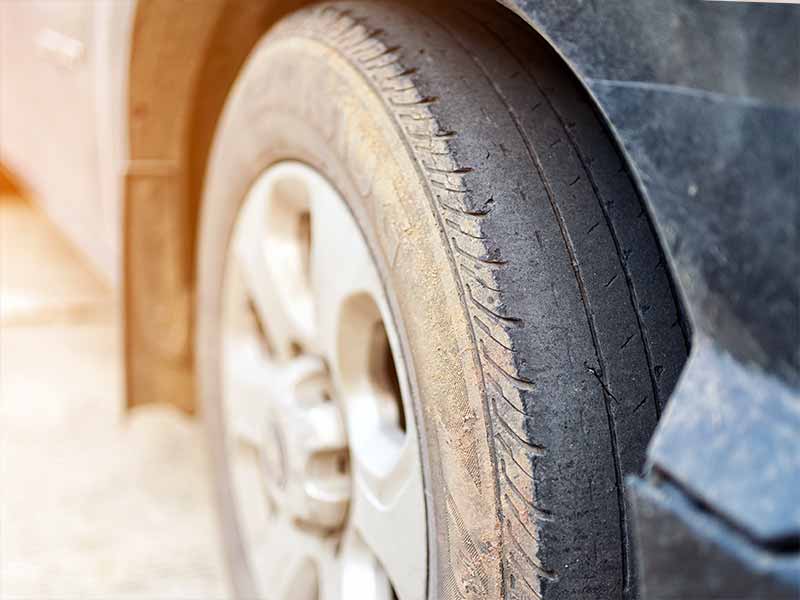New tires typically have a tread depth of 10 or 11/32″ of tread depth. Tires are usually considered bald once they have worn to a depth of 2/32″.
Tire tread wear is important. As a new tire’s tread wears down it slowly loses its ability to maintain traction on slippery roads in wet and rainy conditions.
Once it reaches the minimum allowable tread level, the tires have a significantly increased chance of hydroplaning and stopping distances can more than double on wet roads.
What Are Bald Tires?
Bald tires are any tire that has 2/32″ of tread depth or less at any point across the entire width of the tread pattern. At this point, they are no longer capable of effectively channeling water out from underneath the contact patch and maintaining traction on wet roads.
You can easily tell if your tires are bald with a visual inspection. If the wear bars are even with the adjacent tread blocks at any point, they are considered bald tires.
Tires don’t last forever but there are many things you can do to help insure you get the most life out of your expensive tires.
Let’s take a closer look.
Bald Tires Meaning
2/32″ of tread depth is the point at which your tires are considered bald. Once the depth of the tread grooves in your tire’s tread pattern is this shallow, there isn’t enough space for water to be channeled out from underneath the contact patch.
Worn out tires still provide traction on dry roads without any problem, but without the proper tread depth to allow water to escape from underneath your tire’s tread, they will hydroplane extremely easily.
Worn Or Bald Tires
Tires that have 3/32″ or more of tread depth across the entire width of the tire’s tread pattern are considered worn tires and not yet bald tires. If any point around your tire’s tread pattern has reached 2/32″ of tread depth, they are considered to be bald.
Many driver’s find this frustrating when they see that they have tires that have worn on only a portion of the tires treads but still have plenty of tire tread across the rest of the tread pattern.
Unfortunately, these uneven wear patterns are usually caused by alignment problems, suspension component wear and tear, improper air pressure, not performing regular tire rotation, or aggressive driving habits.
If a tire is more worn at one point on the tire tread than others, this means the tire is using this point the most to maintain grip with the road surface. If it is bald and you find yourself in wet conditions, it is extremely dangerous.
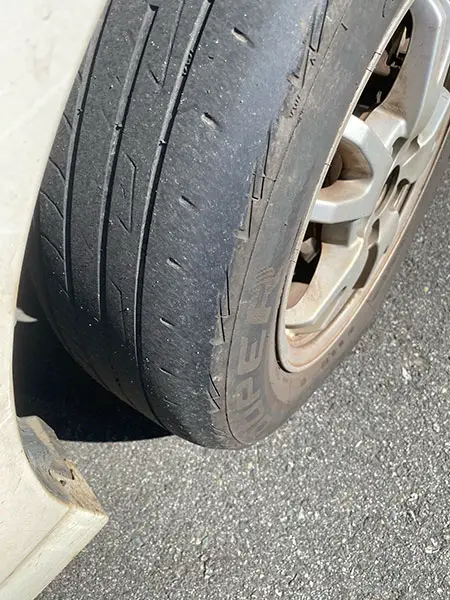
Bald Tires Vs New Tires
The difference in performance between bald tires and new tires on wet road surfaces is massive. Stopping distance can more than double for bald tires compared to the stopping distance of brand new tires in rainy weather during emergency braking situations.
Tires slowly lose traction on wet roads as they wear down and lose tread depth. During this process they slowly increase stopping distances and increase your risk of hydroplaning.
The loss of traction begins slowly at first, but begins increasing more dramatically as your tread wears down close to the legal minimum tread depth.
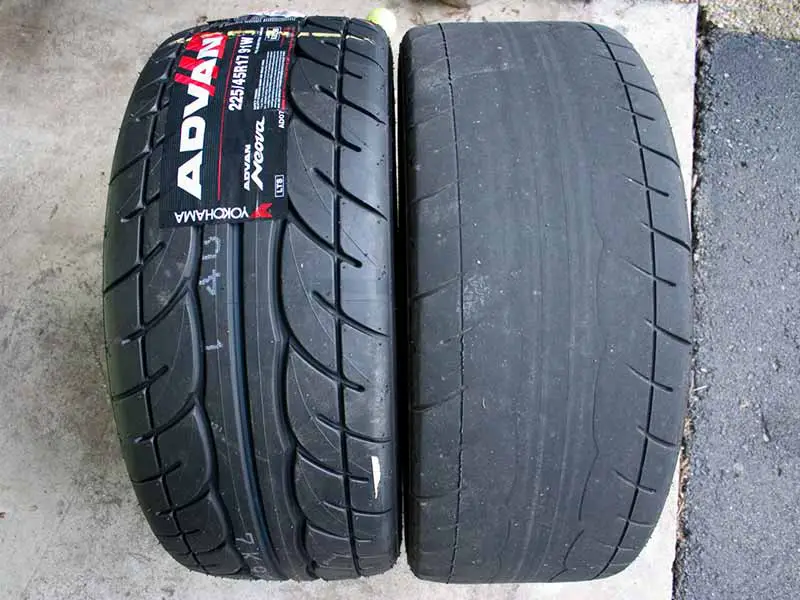
Bald Tires Vs Slicks
Some people find it confusing when they see that race cars use slick tires, and this does make some sense to those that don’t completely understand how tires work.
Tire tread isn’t necessary for traction on dry roads. Tire tread is designed to deal with wet roads, but most people aren’t going to find it convenient to swap their tires from slicks to treaded tires every time rain occurs.
Race teams actually do this. They call their driver into the pits and replace the tires for tires with grooves if they begin experiencing rainy conditions.

How To Tell If Your Tires Are Bald
You can easily tell if your tires are bald by finding the wear bars in the deep grooves in your tire tread. If the surface of your tread pattern is even with the wear bars, it’s time to replace your tires.
Penny Test
The penny test is a convenient method of checking your tire’s tread and determining if they need to be replaced.
- Place a penny upside down in the deep tread grooves between tread ribs.
- If all of Lincoln’s head is visible you should replace your tires immediately.
- If all of Lincoln’s forehead is visible, you should consider replacing your tires soon.
- If part of Lincoln’s forehead is obscured by your tire treads, your tread is at an acceptable depth.
Tread Depth Gauge
To more accurately measure the depth of the tread on your tires you can use a tread depth gauge.
- Insert the probe of your gauge in one of the main grooves in your tire tread design pattern.
- Push down on the top of the gauge until the shoulders of the gauge come to rest on top of the tread blocks and the probe contacts the bottom of the tread groove.
- Remove the gauge from the top of the tread, being careful to not nudge the probe, to read the measurement.
- Repeat the process at several points around the circumference and width of the tire.
Dial Tread Depth Gauge
Are Bald Tires Dangerous?
Driving on bald tires are extremely dangerous, especially in wet weather conditions. They can dramatically increase stopping distances on wet roads and drastically increase the chances of hydroplaning.
While the danger is much less of an issue in sunny weather and dry conditions, driving on bald tires increases the risk of tire failure due to the increased chance of a puncture from low tread.
A bald tire has much less rubber between the inner pressurized air and the tire treads. This makes it much more likely that a foreign object will penetrate all the way through the tire and cause a flat tire.
Flat tires are inconvenient, but a blowout can be catastrophic. Losing control due to a blowout from a bald tire is an unnecessary risk.
What Is Hydroplaning
Hydroplaning is when your tire loses contact with the road surface and begins sliding uncontrollably. The tires are unable to channel water out from underneath the contact patch of the tire fast enough.
Adequate tire tread isn’t the only cause of hydroplaning, but worn tires are a significant factor.
Speed is the biggest cause of hydroplaning. Even bald tires can avoid hydroplaning if you drive slow enough. Unfortunately, the speed you’d have to slow down to isn’t practical and therefore you must replace your worn tires at 2/32″ of wear.
How To Avoid Hydroplaning
Ensuring that your tires have enough tread to adequately channel water out from under your tires is important. But this isn’t the most effective way to prevent hydroplaning.
The best way to avoid hydroplaning is to reduce speed. Now matter how deep the grooves are in your tread pattern, it’s possible to drive faster than they can flow water out from underneath your tires.
Worn tires make it extremely easy for you to drive fast enough to exceed the ability of the tires to maintain grip with the road surface.
What Do Bald Tires Look Like?
A bald tire is any tire that has wear on any portion of the tread pattern that is at or below 2/32″ of tread block height.
Here are some examples:
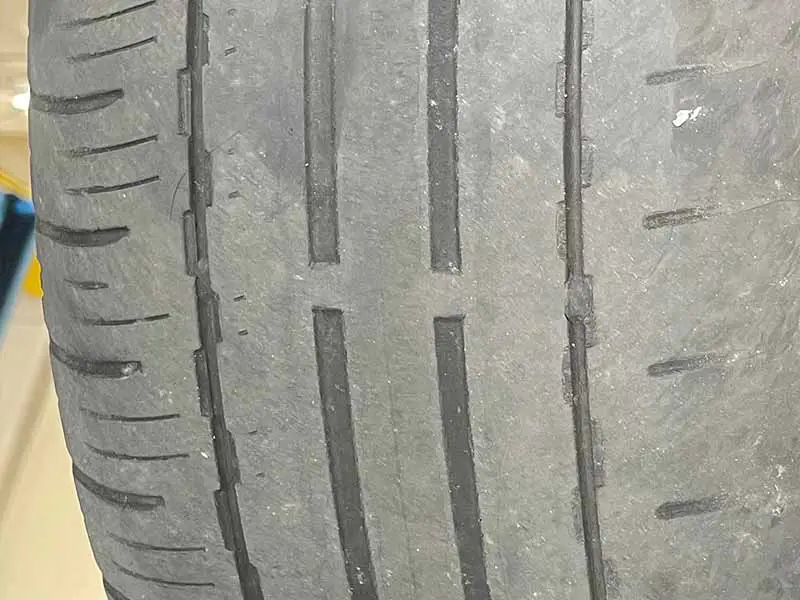
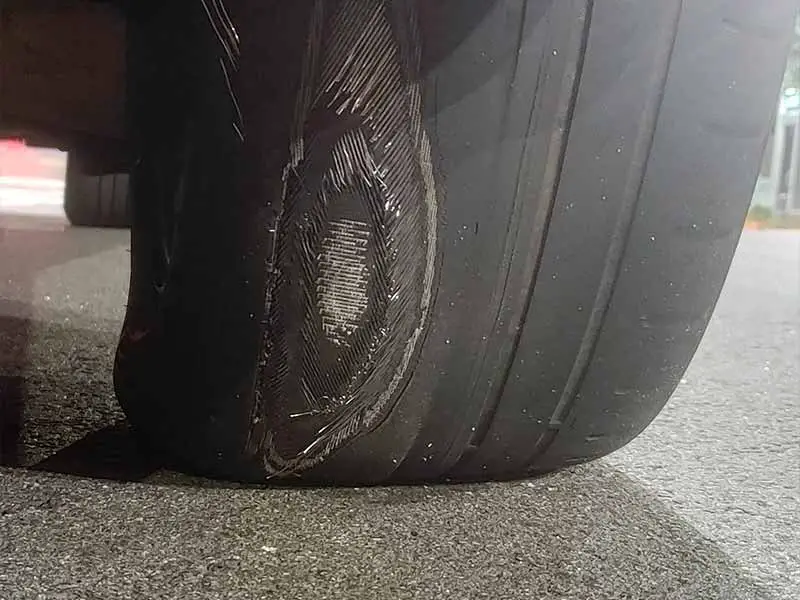
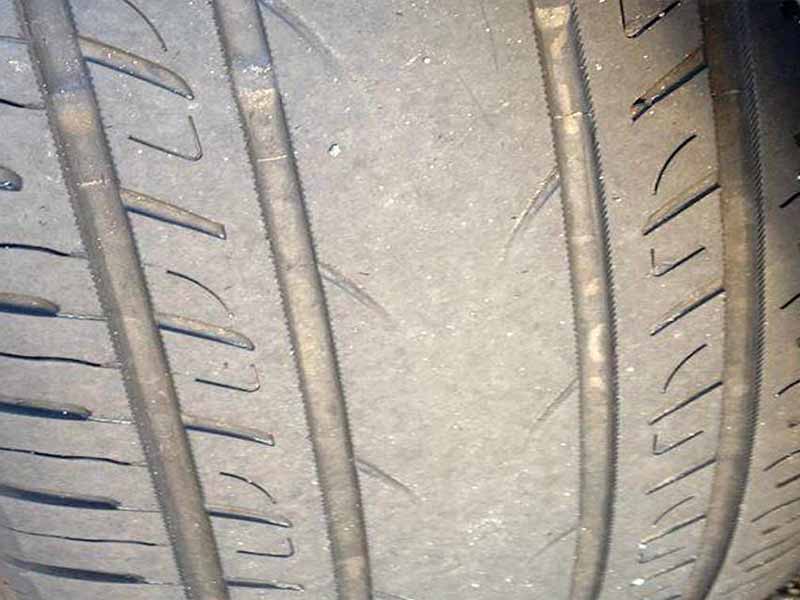
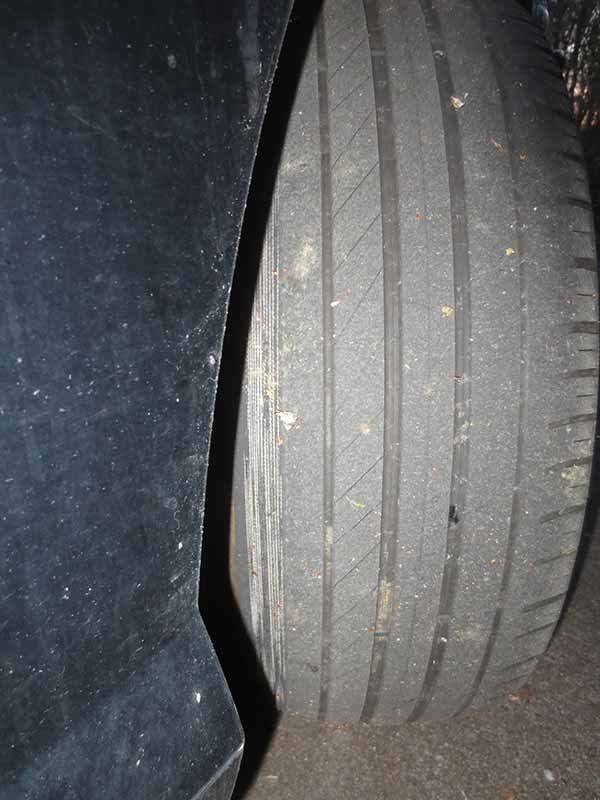
Are Bald Tires Illegal?
It’s illegal to drive on bald tires in most states. A tire is usually considered bald once it reaches 2/32″ of remaining tread, however this varies from state to state. For instance, Florida allows a tire’s tread to wear down to 1/32″ before requiring your tires be replaced.
Despite the legal minimum required amount of tread where you live, replacing your tires before they are considered bald is a smart move for your safety and the safety of others on the road.
Bald Tire Symptoms
Symptoms of driving on bald tires are generally only noticeable in rainy weather. A bald tire will be much more likely to experience hydroplaning and it will also take much more distance and time to come to a complete stop when panic-braking.
More road noise is often reported with bald tires due to the smaller amount of rubber remaining on the tire treads.
Bald tires are easily punctured since road debris won’t simply lodge in a tread block. Due to the thinner amount of material, it takes very little for a foreign object to penetrate through and cause a flat tire or tire blowouts.
Hydroplaning Effects
Hydroplaning feels like floating and can be very eerie and unsettling when it occurs. You lose complete vehicle control of your car or truck and are along for the ride.
- You may notice that turning the steering wheel has no effect whatsoever and the vehicle will continue straight.
- Applying the brakes will also have no effect and will not cause you to slow down.
- Pressing the accelerator can cause the tires to spin and you may hear the engine rev without feeling any acceleration.
Panic-Braking On Wet Surfaces
It’s extremely easy to exceed the abilities of bald tires on wet roads. Worn out tires can’t maintain traction as easily and cause traction control systems and anti-lock brakes to struggle to find a traction in emergency situations.
This lack of traction ability will cause even the best traction control systems and ABS to struggle and increase stopping distances to double or more than that of new tires.
What Causes Bald Tires?
While it’s obvious that tires will eventually wear out, there are many factors that will cause worn out tires more quickly.
Proper tire maintenance can help you get more tire life out of your new tires and slow how quickly your worn tires wear before you need to replace them.
Here are the key tire maintenance practices to slow tire tread wear and extend tire life:
Air Pressure
Maintaining proper tire pressure is extremely important to ensuring your tires wear evenly and last as long as possible.
Tire pressure monitoring systems (TPMS) are designed to alert you when your air pressure drops by more than 25%. This means you could have been driving on underinflated tires for months before the TPMS provides an alert.
The National Highway Traffic Safety Administration (NHTSA) recommends checking your tire pressure monthly. I realize many drivers won’t do this, but if you can take a moment to check your tire’s air pressures every 3 months at least, your tires will last much longer.
Wheel Alignment
Misalignment of suspension geometry is the primary cause of many uneven tire wear patterns and responsible for causing worn out tires.
It’s recommended that you have your wheels aligned every 10,000 miles to prevent uneven wear that will rapidly cause a bald tire due to a portion of the tread being completely worn.
Tire Rotation
Regular tire rotation is important for maintaining the tire manufacturer’s warranty and mileage guarantee. It will also help ensure your tires wear as evenly as possible.
It’s recommended that you rotate your tires every 5,000 miles since this will meet or exceed the requirements of most tire manufacturers and better distribute the unique tire wear patterns of each tire position to every tire.
Tire Balance
Balancing wheel and tire assemblies should be performed regularly since tires can lose balance as they become worn. Wheels can also become unbalanced due to curb strikes and potholes or losing wheel weights over time.
Out of balance tires can cause uneven wear known as cupping. Balance issues can also cause steering wheel vibration or vibrations felt through the seat of floorboard of your car or truck.
Suspension Component Wear
Potholes and curb strikes not only damage rims, but they can damage suspension components and cause problems with wheel alignment.
Even the best driver that managed to avoid every pot hole and curb will still experience worn suspension components over time.
Control arm bushings and worn shocks can cause uneven wear that can can cause a prematurely bald tire.
Resources
Below are some links you may find helpful when learning about tires
- Bald tires: Knowing the what, why, signs, and risks – Bridgestone
- Are my tires bald? Here’s how to tell – Firestone
Final Thoughts
Having adequate tread life remaining is the best method of ensuring your tires are safe for use in the rain and on wet roads.
A bald tire can’t maintain grip properly if there isn’t deep enough grooves in-between the tread blocks. Once tire’s reach 2/32″ of tread they are considered to be bald in most states.
Be sure to properly maintain your tires to get the most life out of your tire’s tread and maintain a safe margin for driving in wet conditions.
Good luck and happy motoring.
